Stowage is an essential process in roadway freight transport. If done incorrectly or negligently, it can lead to a lot of headache. And even more serious, it can cause accidents.
Up until now, however, this aspect was largely up to the transporter’s good intentions. This is why we welcome as good news that last 2 June 2017, Royal Decree 563/2017 was approved. This regulates technical inspections for freight vehicles within Spanish territory, entering in force in May 2018. But what does this mean for those who intend to ship freight by roadway?
Specifying the law to adapt to the EU
It should be noted that the new stowage law is much more precise than before in the Reglamento General de Circulación (General Traffic Rules of Spain). Its article 14 stated that the load must not “drag, fall totally or partially or move about dangerously,” “compromise the vehicle’s stability” or “make noise, raise dust or other inconveniences that may be avoided.”
It proves obvious that this regulation hardly outlined a concept, without providing effective rules to ensure lorry stowage. This situation led to freight vehicle traffic with hardly any control, thus creating potential risks for the transporters and third parties. It is estimated that improper load stowage is an essential factor in transport accidents. Even without mentioning hazardous goods, improper stowage is an impact factor in between 25 and 45% of cases.
Additionally, the new law closes a legal loophole that was unsustainable within the European Union, whose Directive 2014/47 EU is now adapted to the new ordinance.
Stricter technical inspections
Complying with this regulation is imperative starting immediately, given that the DGT (Directorate General of Traffic) has announced that it will conduct over 15,000 technical inspections per year, and the Civil Guard is already prepared to stop vehicles to verify that they comply with requirements. These inspections will be performed without prior warning, and will scrutinise the vehicle’s technical inspection certificates. They will also include a visual inspection of load securing, and other aspects.
The new standard’s Annex III regulates all stowage casuistry and issues: for example, the number of straps, strap capacity or packaging for transport. This is now detailed in the law with all kinds of physical and technical considerations.
In other words, we can no longer just strap down freight however we want. The loader must provide approved stowage files that specify aspects such as the vehicle used, the technique used for strapping and the number of elements to be used, or the tension necessary to counteract the force of the moving vehicle.
Additionally, safety requirements all over Europe are analogous, as well as inspections. This makes the new requirement strictly necessary for anyone wishing to transport goods by roadway. Failure to comply may lead to economic sanctions and immobilisation of the vehicle.
The importance of start-to-finish stowage management
In short, the new law requires avoiding all freight movement during transport, such as sliding, tilting, swaying, substantial deformation and rotation with closure, blockage or strapping methods, or a combination of these methods, to protect both people participating in the stowage process and the driver and other roadway users.
A new stowage law which, thanks to its strictness, emphasises the role of companies specialised in loads that require special handling, taking care of the entire process, from initial transport planning to freight loading, and lastly, a self-safety inspection to verify that everything is correct. This is what Bilogistik does, whose fleet of lorries is entirely prepared to make sure you freight arrives at its destination with full safety guarantees, so you don’t have to worry about anything.


